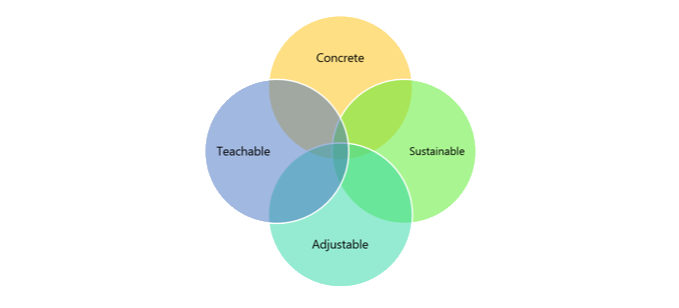Have you ever built a new system, only to watch it fall apart over time? Chances are, it wasn’t just because “change is hard.” It was because the system was missing these key elements.
Good systems are…
- Concrete
- Sustainable
- Adjustable
- Teachable
1) Concrete
Let’s say you’ve just been hired to run a new department. Some business processes are already in place, and many will need to be built from scratch.
The best way to get a handle on all these systems is by concretizing them. In other words, writing them down, mapping them, making them tangible.
My favorite way to map a system is with a flowchart. Flowcharts have connected boxes; each box is a step, and the arrows between the boxes indicate the flow of events. You can even indicate which team members should manage which steps by adding swim lanes. (Click here for more information about building effective flowcharts.)
Best of all, concrete systems help you notice inefficiencies on paper before they happen in reality. They can also help unite your new department around a shared understanding of how things should run.
2) Sustainable
So, now your department’s processes are concrete. But now you need to focus on the quality and characteristics of those processes. Most importantly, you need to determine: are these systems sustainable?
Sustainable systems can repeat indefinitely without drawing on limited resources, such as time, energy, or money. If you see one of your systems has a bottleneck — a resource constraint or inefficiency that impedes production/productivity — you need to remove it.
One of the best ways to determine the sustainability of a system is to start using it. You will quickly realize, “Yikes, this sequence of steps relies too heavily on X. We’re bound to get backed up.” Adjust the system to remove those pain points.
3) Adjustable
Great, now your department’s systems are both concrete and sustainable. But what if your company decides to pivot? Or what if you lose a team member?
Your systems need to be constantly adjustable. Even if you think your processes are perfect right now, your business needs are bound to change. And when that happens, instead of saying, “Our system doesn’t work now… now it’s a free-for-all,” think about what good elements can be salvaged. Use your previous system as a stepping stone into the next iteration.
4) Teachable
Your department’s systems are now concrete, sustainable, and adjustable, but there’s one thing missing. Your systems need to be teachable too; in other words, easily explained to (and adopted by) a newcomer. Especially since your new department will be growing!
Having your systems mapped out on paper is a good start, since you can hand the documents off to a newcomer. But can you hand them off without explanation? What is the process for showing someone the ropes?
Too often, systems come to a halt while they’re being taught to newcomers. Take time now to determine how best to teach your system, so your production and efficiency never slow down.
Action items:
- Identify two important systems (one professional, one personal) that you’d like to improve.
- Concretize the systems by documenting each one in a flowchart.
- Adjust the systems to remove all bottlenecks.
- Put your new systems into practice immediately. Notice pain points as they occur and make continual adjustments.

